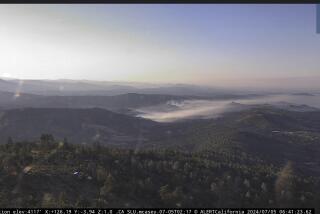10 Years Later, Mt. St. Helens’ Mark Indelible
People remember exactly what they were doing 10 years ago this May 18: getting ready for church, taking care of chores, sipping cups of coffee.
Then, in the bright morning sky, what looked like a huge thunder cloud appeared. A volcanic eruption had lowered the summit of Mt. St. Helens by 1,312 feet. Within 10 minutes, an avalanche of volcanic debris plummeted 14 miles down a river valley. Eerily, people in nearby towns heard nothing, while the sound bounced off the atmosphere and was heard hundreds of miles away.
Generations of campers had used Spirit Lake, a cold, clear body of water surrounded by a majestic forest. The blast emptied the lake and threw it against nearby ridges, while a 1,100-degree pumice poured from the Mt. St. Helens shattered north flank into the basin. The lake was sterilized.
The heat and force traveled at speeds of up to 670 miles an hour, killing 57 people, and untold numbers of deer, elk, bear and fish and birds. Trees were knocked down or burned to death in a 200-square-mile area.
For several winters after, fears lingered that debris-clogged rivers would flood cities downstream. Given the awesome forces at work, geologists wondered whether the towns of Longview, Kelso and Castle Rock, home to more than 50,000 people, were worth saving. At the same time, the worst recession in 50 years hit the region.
“One test of character is how you react to pressure, and, boy, did we have pressure,” said Ted Natt, editor and publisher of the Longview Daily News. In the end, he said, all the adversity “proved to this community that it had the toughness, the character to come through a major natural disaster and survive.”
Today, the economy is recovering, the volcano has been quiet since October, 1986, forests are regenerating at a rate that has surprised scientists and a large herd of elk has migrated into the blast area.
“You actually forget that it’s there, that it’s an active volcano,” said Karen Kruse, among the Toutle River Valley residents who were evacuated 10 years ago. Last fall, for the first time since the eruption, Kruse went to an area that had been devastated and picked blackberries for her family’s annual supply of pie.
But even as land and lives mend, the volcano has changed this corner of Southwestern Washington forever.
Like a meticulous back yard gardener, Charlie Crisafulli steadied the stakes that protect hisplot. The plants are scruffy and the patch small, 11-by-13 yards. But to the 32-year-old U.S. Forest Service ecologist, the garden of lupine, fireweed and dandelion is “the foundation of a forest.”
He calls it East Lupine Plot in honor of the first plant, a prairie lupine, seen growing at the foot of Mt. St. Helens. While young forests cover much of the outlying land scorched 10 years ago, East Lupine Plot is one of the few signs of life in a place known as the Pumice Plain.
A brown-gray expanse, the Pumice Plain was so devastated by the volcano’s fury that nothing survived. Wind whips down it without obstacle, swirling ash and dust. Creeks appear suddenly, carve deep gullies, then shift channels. Cooked boulders tossed out by Mt. St. Helens weather into hues of orange and purple.
In this harsh environment, Crisafulli’s garden grows, slowly, ever so precariously. Growing flush to the ground, the lupine, spotted in June, 1982, trapped other seeds, enriched the soil, and was food to insects.
Crisafulli has catalogued each minute change for eight seasons. Now, he counts 27 species of plants, 160,000 plants in all, plus aphids, beetles and spiders.
“I have so much of my life tied up in it,” Crisafulli said. “But it goes beyond that. It is science. The information generated from these sites is priceless.”
Crisafulli believes that each time a Cascade Range volcano has erupted, islands of life like East Lupine Plot have taken hold and, over decades, evolved into forests.
Not far away, Mt. St. Helens’ crater steams, as springs bubble forth at near boiling temperatures. The springs feed a creek that flows into Spirit Lake. Along the creek, shrub-like willows grow. In time, the willows may colonize East Lupine Plot. Alder and fir trees will follow. In 50 years, perhaps, Pumice Plain will support a young forest.
These days, gawkers rarely come to see the destruction in the Toutle River Valley. There’s not much to see anyway. Alder and willow obscure the remnants of riverfront houses and washed out bridges.
“A stranger looks and has no idea what was there,” said George Basie, a longshoreman who lives above the Toutle River. Before the mountain blew, he could look across a pasture to acres of fir trees. The flood destroyed the forest and washed the homes of nine neighbors into the river.
One neighbor was Ted Conradi. For 40 years, Conradi and his wife, Anabel, lived on 170 acres of tall fir trees and planned to will it to the state for a park.
The Conradis left on the day the mountain blew. They returned a few days later to a moonscape. The next day Anabel had a stroke and never recovered. They moved, never to return.
Occasionally, Conradi goes back to his abandoned home. Holly trees in the front yard grow wild. The porch steps are rotted. Derelict cars and trucks rust in the yard.
“I have halfway made my peace with the mountain,” said Conradi, 79. But he prefers to stay in Kelso. “I’ve accepted something that happened, the loss of something that can’t be replaced.”
Ann and Sam Hornstra still find their loss hard to take. “We don’t need a reminder,” Ann Hornstra said, not at all nostalgic about the 10-year anniversary. “We work in it every day.”
In 1978, the Hornstras sold a dairy in Orange County and moved to 110 acres on the Cowlitz River. It was a perfect place to retire. They ran a few head of cattle and tended a grove of filbert and walnut trees.
Then, 30 miles away, Mt. St. Helens blew. Slurry-like floodwaters dumped part of a mobile home on their pasture, along with logs, animals and enough appliances to furnish two homes. The couple is still clearing the debris.
“Our orchard used to be right there,” Sam Hornstra said, pointing to a spot covered with grass. “It used to be good soil, beautiful soil.”
The mud dried like cement, 35 feet deep in places. Cottonwood trees washed in by the flood sprout haphazardly. Ann Hornstra raked much of the pasture by hand. But some soil is beyond help.
The farm retains beauty. A lush apple tree blooms outside their kitchen window. Cattle graze in the pasture. But the Hornstras remember the place as it was, and recently put it up for sale. “If we knew then what we know now,” Ann Hornstra said, “we would have walked away.”
Van Youngquist entered politics intent on spending only one four-year term as a Cowlitz County commissioner, then returning to his dairy on the Columbia River. Halfway through his term, the mountain erupted. He has been working on volcano-related problems ever since and gave up the dairy.
His biggest worry had been that a natural dam holding back Spirit Lake would break, flooding the Toutle and Cowlitz rivers and towns below. But the Corps of Engineers dredged river channels, built a spillway to lower the lake, and last year completed a dam on the Toutle to hold back sediment.
Now, Youngquist fears that another natural dam holding back Castle Lake could fail, flooding parts of the towns of Castle Rock and Kelso. Although the lake is much smaller than Spirit Lake, Youngquist said: “I don’t trust it one bit.”
Last year, a Federal Emergency Management Agency consultant reported seeing considerable erosion on the Castle Lake dam, and warned that “the system itself is so fraught with potential for danger as to render it unsafe in the general sense.” Another study is under way.
Youngquist knows that volcano-related problems persist a decade later. But “the average Joe Blow doesn’t know or care about Castle Lake. He has been here for 10 years and has never gotten his feet wet.”
Blair Barner was three days away from finishing his new home, an A-frame, a short stroll fromthe North Fork of the Toutle River. After a lifetime of fishing on the river, he could catch his limit of steelhead on any day. Then the eruption spawned the flood on the Toutle, leaving his home waist deep in mud.
Fishermen used to pull 3,000 steelhead from Barner’s river each winter. Although runs on some rivers in the area are better than before the eruption, a paltry 30 steelhead appeared at a dam upstream from Barner’s A-frame this winter.
Barner and a partner try to make something good from the misfortune. They put a hulking statue of Big Foot next to the A-frame and opened a gift shop. But Barner never could bring himself to charge admission to his dream house.
“People think its a real good business,” Barner said. “But in the wintertime, you might see five cars in a day.”
Officials believe tourism will take off. Youngquist points to estimates that 2 million visitors will come by 1993 after a road is finished that will take people from Interstate 5 to within 4 miles from the crater.
The U.S. Forest Service manages a 110,000-acre national volcanic monument established by Congress like a national park. The Forest Service already has put in an extensive system of trails that soon will lead to the Pumice Plain.
A series of events, including a symposium, festivals and a memorial, will mark the 10th anniversary weekend. To commemorate the dead, the Forest Service will put up a plaque at its visitors’ center this summer. A spokesman said there will be no elaborate ceremony.
“It hurt us. It took 10 years of logging away from us,” said Bill Welch, 49, who drives a log truck for Weyerhaeuser Co., the area’s largest employer.
While Weyerhaeuser had 4,800 workers in the area in 1980, the company has about 2,800 employees now. Much of the job loss was due to automation and a bad economy. But the volcano scorched 68,000 acres of Weyerhaeuser land, and “hastened” the closure of mills that cut old-growth trees, said John E. Keatley, Weyerhaeuser’s land and timber manager in the affected area.
Weyerhaeuser planted 18 million trees on 45,000 acres in the largest reforestation effort ever in this country and found that the trees are growing exceptionally fast.
“We were surprised by the resiliency of these plants and animals,” Keatley said.
In the regeneration, Keatley said, Weyerhaeuser finds support for its contention that clear-cutting does no lasting damage to the forests. Like other timber companies, Weyerhaeuser continues to clear-cut, then burn what remains before growing new “crops” of trees.
But Peter Frenzen, U.S. Forest Service’s chief scientist at the monument, observed regeneration on Forest Service land and became an adherent of a new theory on logging. To revive coniferous forests, it is important to leave some dead logs and not disturb the general “disorder in nature.”
Frenzen stood amid dead fir trees in a stand left to regenerate on its own. He explained how rodents called voles use downed logs for protection and tunnels. Voles gather and spread spores from mushrooms that, in turn, help fir trees grow. The animals also are a main source of food for spotted owls.
“We are trying to regenerate more than just trees,” Frenzen said, proud of his own crop of fast-growing plants and animals on the south side of Mt. St. Helens. “We are trying to regenerate entire ecosystems.”
Ed Wolfe, the U.S. Geological Survey scientist in charge of the Cascades Volcano Observatory in Vancouver, Wash., takes a long view about Mt. St. Helens. Over the last 12,000 years, Cascade volcanoes from Washington to California have erupted at a rate of two per century.
“That will very likely continue,” Wolfe said.
Geologists believe Mt. St. Helens is returning to dormancy. But it still could erupt, ending the recovery of the last 10 years. “We can’t become complacent,” Wolfe said.
In geological terms, Mt. St. Helens’ eruption was “modest.” Because of their size, eruptions on Mt. Hood, outside Portland, Ore., or Mt. Ranier, outside the Seattle area, would pose far greater problems.
Last month, someone reported a new source of steam on Mt. Hood. It was, in all likelihood, nothing. “Before, no one would have paid any attention to it,” U.S. Geological Survey scientist Don Swanson said. “Now, someone will go out and look.”
More to Read
Start your day right
Sign up for Essential California for news, features and recommendations from the L.A. Times and beyond in your inbox six days a week.
You may occasionally receive promotional content from the Los Angeles Times.





